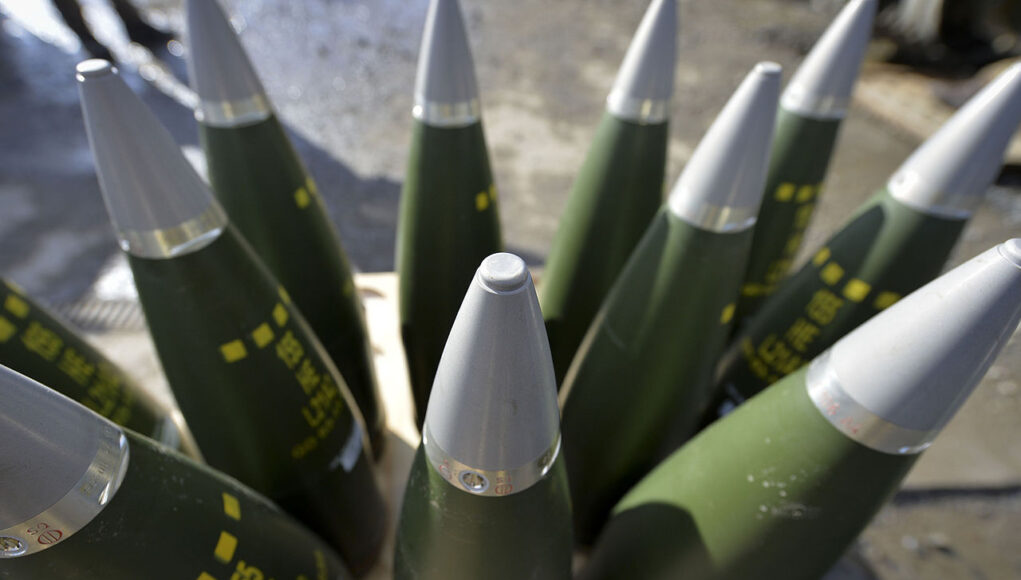NATO, in a move to strengthen its ammunition reserves, concluded contracts for the procurement of approximately 220,000 155-millimetre artillery shells, amounting to a substantial 1.2 billion US dollars.
The contracts were finalised by Secretary General Jens Stoltenberg and Stacy Cummings, General Manager of the NATO Support and Procurement Agency (NSPA), on Tuesday (23 January 2024).
Secretary General Stoltenberg emphasised the strategic significance of the procurement, stating, “This demonstrates that NATO’s tried and tested structures for joint procurement are delivering. Russia’s war in Ukraine has become a battle for ammunition, so it is important that Allies refill their own stocks, as we continue to support Ukraine.”
The purchase is part of NATO’s approach to maintaining and enhancing its military capabilities, as outlined in the Defence Production Action Plan agreed upon by Allied leaders in July 2023.
Since then, the NSPA has executed contracts valued at around 10 billion dollars, covering a wide spectrum of military needs. These include a substantial 5.5 billion dollar contract for 1,000 Patriot missiles and another 4 billion dollars dedicated to 155-mm artillery, anti-tank guided missiles, and tank ammunition.













Divert most of them to Ukraine please
Isn’t 220 000 more or less the amount used in Ukraine per year?
More than that. The USA sent more than 1 million 155mm and they burned it in 6 months.
No doubt the British Def secretary will subscribe to the view that the Uk can afford to cut its military spending as there are better things to spend money on, such as his expense account
I saw Grant Shapps had been to Japan to tout the CSG 2025 deployment to the far east. He stood in front of JMSDF destoryer Maya- a 12,000 ton AEGIS equipped super destroyer sprouting off about how no nation should under estimate the UK’s armed forces, I was left deflated.
How he can possibly state that when the RN is down to what 15 active destroyers and frigates, is considering scrapping our LPDs and both carriers have no more than 34 F35B jets able to be deployed onto them. with a further order for 26 more aircraft stalled because the British weapon systems integration is so delayed it isnt going to be until 2030+ when meteor, spear 3, brimstone etc etc are integrated, if ever.
I think the UK should push on with Tempest and get the type into service PDQ and not order any more F35Bs until weapons integration Block 4 is completed- switch everything over to another batch of typhoon and a crash programme to get the worlds first 6th gen fighter into service, followed by a huge order for Tempest.
Another batch of typhoon makes a lot of sense at this time. freeing up the f35B for both carriers to deploy with the 47 available aircraft by 2025-2026 timeframe.
Yep pretty overblown garbage, I wonder if he does stand up ? Bottom line is absolutely nothing is going to get done because no British Government is interested anymore.
As for the Tempest project believe it or not the proposed development plan is as near as you will get to rapid. Check out the Russian, US, Chinese and Franco / German ones for comparison.
The development phase for Tempest is about as long as the block IV upgrade for F35 to put it in comparison.
That being said the B21 is the first digitally designed military aircraft and the project seems to be moving rapidly and with in budget.
That may bode well for Tempest which is using the same process.
Hi Jim, something we can learn from.
Rising B-21 production costs lead to $1.6B charge for Northrop
WASHINGTON — Northrop Grumman reported a nearly $1.6 billion pre-tax charge on the B-21 Raider program in the last quarter of 2023, as the stealth bomber moved into its low-rate initial production phase.
The charge was mainly caused by higher-than-expected production costs and macroeconomic disruptions, company officials said in an earnings call with investors Thursday. The B-21′s charge included $143 million in cost growth on the first LRIP lot, they said.
The Air Force plans to field a fleet of at least 100 of the Northrop-made bombers, beginning in the mid-2020s. The B-21 is designed with the latest stealth technology and intended to penetrate deep into enemy territory for strike missions, even against adversaries with the latest radar and air defenses.
The B-21 program has been relatively successful and on schedule so far. It was publicly rolled out in December 2022, and almost a year later, moved into the flight testing phase at Edwards Air Force Base in California. The Pentagon was impressed enough with the results of the B-21′s ground and flight tests to start production late last year.
But throughout 2023, Northrop Chief Executive Officer Kathy Warden repeatedly warned investors that losses were likely as the B-21 moved into production — losses that are now starting to materialize.
Great point Jim, it hopefully demonstrates that the great changes in software development and towards modularisation and digital twinning since the F-35 inauguration isn’t just hype and are meaningful in reducing development time and previously baked in lack of flexibility.
As for Tempest itself, I also think the combination of UK, Japan and Leonardo is at least potentially made in heaven at least compared with dealing with the French or Germans or indeed Americans who tend to see us as the useful idiots of technology exchange and cooperation. Japan can offer so much in terms of fit with UK military technology expertise that benefit both in a complimentary fashion and Leonardo has seriously developed into a World renowned technology giant that adds to both other partners skill-base. It equally has the Italian Govt onboard simply because they are well aware of their need to support it as a National champion so I think Tempest has a great chance to thrive despite what inevitable hiccups it might face along the way. Uk Govt is probably potentially its weakest link potentially because we have a long history of not following through with our initial hopes not through lack of ability but financial limitations. Hopefully Ukraine if nothing else makes such mid term withdrawals a little less likely.
There won’t be a huge order for Tempest. Do you honestly think a 6th gen fighter is going to be cheap? The future is unmanned. Tempest will be a manned fighter, but not in large numbers. 100 at the most. Probably less. It will manage larger numbers of loyal wingman drones. Drones will bring future mass, not manned platforms. We have some lethal capabilities. None of us are in denial about the problems facing our Armed Force’s. But I’m sick of people acting like we have turned into the Irish defence force. You can’t keep harking back to passed force structures. Our Force’s today, even though much smaller, are much more capable compared to the 90s or 2000s. F35 today is deadly. People just don’t understand the capability. F35 is much more capable than Typhoon in many ways. The RAF wouldn’t but more Typhoon now that have experienced 5th gen stealth capability.
Tempest will have the ability to fly unmanned.
Planes have been getting cheaper since the 80’s
F14 in adjusted dollars were about $300 million a go, F35 coming in as low as $80 million in same year dollars.
Look at the cost of B21 compared to B2.
CAD may actually be a game changer for Tempest.
A new Typhoon, even after 20+ years of production, is still 80+M. That’s is not particularly cheap. NGAD is projected to cost $200/300+ million a pop. New technologies will bring huge benefits to Tempest, but anyone thinking a 6th gen capable fighter is going to be cheap are kidding themselves.
We know that Typhoon costs are greatly the result of the production structure which was far from commercially viable if looked at objectively and a lot due to German intransigence and indecision. That cannot be repeated.
Just read up on potential costs re US efforts though can only generalise as these things don’t stick in my brain. However originally a super F-22 was proposed rather than a brand new design and this was the idea that Japan would have participated in. It would involved F-35 like sensors and electronics upgrades and the stealth advances like embedded coatings rather than applied coatings on the F-22 which come tend to require new applications if super cruise is used for any length of time. Cutting to the bone two options were considered updating around 100 airframes (maybe just over) which is the number that are still operational or opening a new production line which considering the old one now builds F-35s and most of the jigs and tooling and most of those involved no longer work there would be no easy task and require new build facilities. So two costs assessments were made and certainly one came out at over 200m per airframe. Considering it would have only delayed a new design by 20 years or so not surprisingly once it was seen that Russia and China were building competing Gen 5 designs and potentially in large numbers this was rejected for the new Gen 6 design that we see resolving into the new US programmes for the Airforce and Navy which it is calculated will end up cheaper. Indeed the F-22 upgrades/newbuilds would only ever have been considered feasible because surprise, surprise the US were expecting Japan to finance most of the effort while of course demanding considerable control and restrictions on the final product limiting the Japanese ability to develop their own skills. Shows why Japan and Britain have much in common moving forward together.
It was a mistake to cap F22 production at 197 airframes. Now F15C’s are having to soldier on that are becoming very maintenance heavy due to their age and the very expensive F15EX wouldn’t have been necessary. The stealth technology on F35 is much more maintenance friendly compared to F22. But with investment, that could be applied to F22. It’s still an outstanding aircraft. But F35A now provides much of the air dominace capability of F22 along with strike/ electronic attack. The radar and avionics are a generation ahead of F22. And with blk4, its capabilities will keep it ahead well into the 2040s and beyond.
Agreed still speculative but it’s at the core of how expensive present or future jets will be.
F35 is not that good. It is way too expensive to operate and has short legs. The advantages are two fold: stealth and data fusion. Stealth is vanishing in 2027 and can currently be countered by passive tracking. Data fusion will be matched by Rafale F5 and other planes. So what will be left except high hour flying costs?
6gen is a concept. No one knows the plateform yet.
Stealth is not vanishing in 2027. If so, why are the new 6th gen all going to be all aspect stealth. The F35 will have engaged and got missiles in the air at range before any adversary even knows it’s been engaged. Data fusion is not matched by the Rafale. Rafale still requires external pods. Its radar array size is tiny. It doesn’t have the computer power, or electrical generation power of the F35, or all aspect stealth. F35 carries more fuel internally than any other western fighter. There are very good reasons why so many nations are ordering F35. They have experienced its 5th gen capabilities. And realised nothing else is really coming close. Rafale is still very capable, just like Typhoon. But F35 brings unmatched capabilities, especially when operating in very high threat environments. Electronic attack. SEAD/DEAD capabilities are also other capabilities F35 brings that are part of its avionics fit out. It doesn’t require bolt on external pods to fulfill these roles.
I hope you’re right… though passive sensor get the F35 as recently demonstrated in joint exercise. And due to single engine configuration plus limited trust to weight ratio, F35 has difficulties to fly very low and carry limited quantities of long range air to ground missiles. Ha, let’s hope we don’t have to find out and if so numbers will overcome the odds.
I think the next plane of USA will be fine. Turn’s out that USA is doing a crappy generation of planes, then an outstanding one, and a crappy again.
Look at century series (poor generation) followed by F15 and F16 (outstanding), then F35 (poor), NGAD will be great, techno more mature, leassons of failure learned. Their is this marvelous drone also, developped with Australia. For me, this is a very good concept. Affordable, strong capabilities, easy to produce and maintain. Well that’s my opinion. USA are good when there is a challenge. Otherways, they throw money out of the window. Literaly.
I’ve had 6 pints down the pub. I’ll reply properly to you tomorrow 👍🍻.
Royal Aeronautical Society/NGAD – a generational divide?
“Since improved stealth, supercruise and long range will be the main drivers for the NGAD configuration, it is likely that the AII-X flight demonstrator was focused on the validation of an external shape that reflects the requirement. Under the skin, NGAD requirements should be informed by lessons learned in the F-35 programme.
The F-35 has been chronically short of cooling capability: a GE model of its three-stream engine shown at AFA included a full-diameter heat exchanger in the outer bypass duct – a complex design that would be impossible to fabricate without using additive manufacturing.
The government-owned Agile Mission Suite for NGAD “will have the ability to rapidly adapt to emerging technologies and threats,” according to Air Force Congressional testimony, and will be an open architecture system. It will use the partitioning concept introduced to military aircraft by Saab, where flight-critical functions are separated from mission software.
This contrasts with the integrated central processor on the F-22 and F-35, which requires extensive regression testing of all changes to ensure that they have not affected other parts of the system. Partitioned avionics are already in use on the B-21 programme, which incorporates a ‘software factory’ that permits rapid updating.”
Agreed. NGAD is a good concept, long legs, fast. It will be able to hit hard long range and will therefore be a tremendous asset for all forces equiped with it. Like the F15 but better. Loyal wingman drones will be a must have. This will bring on consumables and firepower. The computing abord NGAD will enable network centric combat capabilities that will be needed considering the upcoming vulnerabilities of all Awacs plateforme due to long range missiles. Radar stealth is no longer the goal. Gallium nitrite radar, quantum radar, multistatic radar and passive sensor kill this idea gradually. Deployement of these technologies will start in 2027, so this advantage will be vanishing quickly.
Now, everybody need long range strike capabilities to avoid sam rich environment for raiding parties.
I understand very well UK decision makers to avoid further F35 orders. It is a trap, an deadly one for any air force.
With a bottomless pit which we can ill afford. Now add in the cost of the engine upgrades, the unit cost of F-35 fighters which will increase due to reduced orders over different lots, and a rush at the end which has already been predicted due to the delays in TR3/Block4 ongoing fiasco while countries wait with the production lines due to close in 2035.
GAO 30 May 2023
“The extra heat is increasing the wear on the engine, reducing its life, and adding $38 billion in maintenance costs.”
“Stealth is vanishing in 2027 and can currently be countered by passive tracking.”
What???
Please do explain.
Stealth works only if F35 has his radar cut. When a F35 uses his radar, he can be detected, tracked and shot, as demonstrated in the Atlantic Trident shoutout by Rafale Spectra + Meteor.
If F35 fly high (it’s mission profile as single engine fighter), it better be in bad weather, because of optic and termal tracking. Anyway, this plane cannot really fly low, it is not safe then (bulky, underpowered), and its engine is not optimal for this.
Foggy weather, Radar off, the stealth somehow works. Low band radar will tell you within 1 to 5 km where the F35 is, but no tracking.
So, for tactics: 1 F35 in the rear with radar up and F35 in front with radar off, and discrete communication between both.
Courvature of earth will give some idea of the detection range limites of f35. At 10 km, one can expect a beam to pick up ground target at 350km, while a target flying itself at 10km heigh can be detected from 700km. I don’t know if F35 radar can go this far, but one can assume it can. This provide an Idea of where the radar should be, where the wingman should be.
That’s what I understand from open source, développement off Loyal Wingmen and Neuron and Rafale F5 in air to air combat.
F35 pilotes will face drones with no pilotes.
Ucav are advanced in Australia and US and are advancing forced march in France. 2027 it is.
“Stealth works only if F35 has his radar cut.”
Have you ever heard of LPI radar that the F-22 and the F-35 uses? Again, go look it up.
What happened in Atlantic trident all the way in 2018 is classified and not publicly disclosed so you are making it up. If you really want to use internet rumors as your source of information then the rumor is “The result was 18-0 against Rafale and 19-0 against Eurofighter and 16-1 against the F-15E.” I can send you the link a a forum where these rumors are shared and you can read it for yourself.
“it better be in bad weather, because of optic and termal tracking. Anyway, this plane cannot really fly low, it is not safe then”
Do you understand that IRST systems are extremely short range and can be severely affected by atmospheric attenuation? The farthest range I have seen reported publicly is 50km compared to the F-35 with an aim120 missile will detect and kill another fighter like for example the rafale at ranges approaching 200km.
Finally to your point about stealth being obsolete, why is France trying to develop nEUROn if stealth is done by 2027. Why is Russia, China, and any other country that has the knowledge and the finance to develop a stealth aircraft trying to?
See the ROYAL AIR FORCE website, what we do/Team Tempest from the dropdown menu for all the factual details 👍🇬🇧
“Tempest will provide several modes of operation, combining manned, unmanned and optionally-manned platforms, with onboard and off-board data processing and a range of pilot decision aids when manned flight is being conducted.
This is called scalable autonomy.
Scalable autonomy will be key in the future as operating environments become more complex and threats become more sophisticated and dangerous.
Speed, manoeuvrability and payload will also be key in the future. Our aerodynamicists and engineers are optimising the aerodynamic performance of the Tempest concepts to achieve what we call ‘balanced survivability design’.”
GCAP is probably going to prioritise aerodynamic capability where NGAD will prioritise low frequency stealth.
GCAP will have some form of horizontal stabiliser, NGAD will have no tail more like a bomber than a fighter.
Personally I think our approach will be better. Stealth over time can always be compromised and it’s pretty useless for air policing roles.
Being highly manuverable will always come in handy.
No doubt Lockheed will claim at some point GCAP not 6th Gen for this reason but a 5.5gen.
Stealth and the best possible situational awareness is exactly what you want in any given role.
Must admit those factors were in my mind the decisive factors but having read recently about the negative effects of tailless designs I’m less committed to that primacy than I was. In the end I guess the line of balance between positive and negative factors is just how effective stealth factors remains and how, much influenced upon this, the likelihood of direct aerial engagements are going to be. Why does the navy have a different view to the airforce I wonder or is it entirely due to the need to maximise manoeuvrability and control for carrier operations particularly launch and recovery phases rather than any combat considerations. Maybe operating at sea where detection will be different to hostile land scenarios is an influencing factor however.
I wonder how the compromise flattened tail plane we now see on the YF- 23, Tempest and the Chinese designs is a sensible compromise.
Aircraft designed for carrier operations are always a compromise between the desired performance and the slow speed handling characteristics required for landing safely on a carrier. Until we see real technology demonstrators, we are all just guessing about what NGAD and Tempest will look like and what roles they are designed to fulfil. It’s interesting that an official Air Staff requirement has never been released stating exactly what the MOD actually wants Tempest to do. I do think the manned version will only be built in small numbers with the unmanned version and loyal wingman making up the bulk of the mass as the system of systems as the publicity likes to state. 👍
Its always good to keep up to date!
Airforce Technology
January 22 2024
Tempest combat air demonstrator aircraft design and features
“Tempest will be a sixth-generation optionally-manned stealth-capable fighter jet, which will be designed to be connected, flexible and upgradeable to stay ahead of changing threats.
The airframe of the aircraft will be made of advanced composite materials and additives to be able to operate at higher temperatures. It will use digital engineering technology and advanced processes to reduce manufacturing time.
The aircraft will support scalable autonomy, which will enable manned, unmanned and optionally manned operations.
Tempest will be able to support existing weapons, planned weapons and weapons of the future such as Meteor, the next-generation beyond visual range air-to-air missile.
The weapon effects management system will control the coordination of all weapons on the battlefield, using AI and machine learning-enhanced software.
Tempest will feature a defensive aid system capable of tracking, targeting and intercepting incoming missiles.
Mission capabilities
The fighter aircraft will serve as a connected node within a system of systems across all domains in the battlespace.
It will operate in co-ordination with other systems in the FCAS, such as uncrewed combat aircraft, civil platforms, satellites and cybersecurity centres, in future conflicts.
The aircraft will employ artificial intelligence (AI), machine learning and autonomous systems to provide manned/unmanned flying capabilities. It is also expected to use swarming technology to control drones.
It will receive data from different sources to generate reliable information that can be shared with other connected aircraft in a combat cloud.
The aircraft will be able to obtain complete oversight of the battlefield in stealth mode while carrying a significant payload, including next-generation weapons such as directed energy and hypersonic missiles.
Cockpit details
Based on the wearable cockpit technology concept, the cockpit of the Tempest system will be customisable by the pilots with head-mounted display helmets.
The helmets will be used to project next-generation augmented and virtual reality interactive cockpit displays and controls directly in front of the pilot’s eyes. Other concepts such as virtual assistants for pilot support are also being tested.
The aircraft will be fitted with a next-generation flexible, software-driven flight control system. Its reconfigurable communications system will offer secured and seamless communication across air, sea, land and space through a connected network.
The gesture-control and eye-tracking feature in the cockpit will enable the measurement of the pilot’s workload and identification of his/her fatigue and mental stress.
Sensors and radars
The aircraft will be integrated with advanced sensors, which will allow a fast, secure and resilient exchange of information on the battlefield via the combat cloud.
Leonardo is working on an integrated sensing and non-kinetic effects (ISANKE) and integrated communications system (ICS) for Tempest.
It formed a partnership with Mitsubishi Electric to work on the development of JAGUAR sensor technology, which is expected to be used in the development of ISANKE and ICS for the Tempest programme.
ISANKE will provide a sensor network across the airframe. It is expected to unlock the potential of sixth-generation sensors by shifting from distinct equipment to integrated systems. ICS will enable the connection of the ISANKE system to the wider system of systems within the FCAS.
The effectors integrated into the aircraft’s sensors will allow the aircraft to engage with a range of non-kinetic effectors such as electronic warfare jamming and directed-energy weapons.
The effectors will help in assessing and evaluating incoming threats, and then in managing the deployment of the appropriate method to defeat them.”
The Next Generation Air Dominance (NGAD)
“The programme revolutionises the USAF’s modernisation plans by adopting a system-of-systems approach instead of a singular platform.
A sixth-generation fighter aircraft will form the centrepiece of the network-connected NGAD family of systems. It will be complemented by multiple manned aircraft, loyal wingman-style unmanned aerial vehicles, and advanced command, control and communication systems.
The USAF flew a full-scale flight demonstrator as part of the NGAD programme in September 2020.
The modern sixth-generation fighter jet is expected to replace the F-22 Raptor fighter aircraft beginning in 2030.
NGAD fighter jet details
The NGAD fighter aircraft will be deployed to conduct counter-air missions. It will perform air-to-air strikes as well as attack ground-based targets to provide air superiority for the joint force.
The aircraft will provide enhanced survivability, adaptability, persistence, and interoperability in the air domain.
The detailed design and specifications of the aircraft have not been made public due to the classified nature of the programme.
Technologies and acquisition policy changesThe programme benefits substantially from the use of digital engineering, which can help in accelerating the development and production of the aircraft and reducing costs.
The USAF has invested in variable cycle engines with the aim of increasing electrical power generation, while improving cooling.
The acquisition strategy for the NGAD programme seeks to widen the industrial base to bring innovative warfighting capabilities more quickly to the forces.
One of the key objectives is to mitigate challenges encountered in recent acquisition programmes of the USAF. The NGAD will incorporate open architecture standards to enable the implementation of future upgrades.
An open architecture platform will maximise competition for upgrades throughout the life cycle, while cutting down costs related to maintenance and sustainment.
Collaborative combat aircraft
The NGAD fighter is estimated to cost as much as $300m per aircraft. Given the significant cost involved in procuring the next-generation manned aircraft, the USAF is planning to field more number of less-expensive CCAs that can operate in tandem with crewed NGAD fighters or autonomously, providing affordable mass in the combat scenario.
The CCAs flying with the manned fighter jet can seamlessly receive and execute commands from the pilot. They are expected to carry advanced sensors, electronic warfare packages, or additional munition to augment the fighter jet and perform different roles, including as a shooter, jammer, or a sensor.
Funding and budget requests for the NGAD programmeThe NGAD programme is estimated to require $16bn over the next five years through 2028 for research, development, testing and evaluation.”
I’ve been warning about the F-35’s future day-one capability to avoid Chinese radar for donkey’s years on here clearly stating it will be of little use come 2026 that has been proven in US war games on two separate occasions and with all the bells and whistles added to it that we still don’t have and will not have until the 2030s.
“The surprise debut of the Chengdu J-20 stealth fighter at the end of 2010 was China’s most spectacular move, but air power experts increasingly worry about the growing PLA-Navy fleet of air-defence warships and Shaanxi KJ-500 airborne radar platforms.
The latter are believed to be not only used for early warning but also to provide targeting support for long-range anti-air warfare missiles. Counter-air warfare – defeating air- and surface-based defences so that invasion forces can be attacked from the air – is the primary mission of NGAD and its CCA.
Existing aircraft, including the F-35, were designed when Chinese air power was vastly weaker, and with other theatres in mind. Neither the F-35’s range nor its signatures are optimised for Pacific ranges or an all-aspect, wideband threat.
NGAD is intended to exploit new technology, particularly variable-cycle engine (VCE) propulsion which promises higher efficiency at both subsonic and supersonic speed, particularly when mated with a new airframe.
The ‘bowtie’ signature pattern of the F-22 and F-35, with a stronger signature on beam aspects than to the front or rear, was optimised to penetrate a linear air defence system – but in the South China Sea, radar threats are found at all aspects.”
😂😄🤦 What utter garbage. More AI generated rubbish. Wake up and smell the coffee is the most human response your computer can think of.
I should have mentioned this earlier in relation to my earlier post.
Royal Aeronautical Society/NGAD – a generational divide?
Worth reading in full.
An article written by Bill Sweetman, a notorious F35 hater and spreader of misinformation online.
🙄
Why do France, UK, Russia, India, USA, Japan, Korea, Pakistan and more go for hypersonic missiles and no stealth missile. There must be reasons. And we all know them. Stealth is not a viable concept, while hypersonic is.
Stealth is everything. Especially for subsonic cruise missiles.
Hi Robert, I am not so sure. It is working now, but It seems some scalp/store shadow have shot down and that it will become tougher in the future.
I believe in speed and agility in the future.
Have you ever heard off the JASSM, LRASM, LRSO. All new stealthy missiles that are being bought by the US military. The US intends to buy nearly 12,000 JASSM alone.
Interesting. Though I would like to remind one fact: USA is lagging behind Russia, China, North Korea, Pakistan and France in terms of hypersonic weapons. And soon India will join the party. Let’s see if the cooperation with France enables them to get back in the race.
“USA is lagging behind Russia, China, North Korea, Pakistan and France in terms of hypersonic weapons.”
Who told you that???
Other than China, show me just one hypersonic weapon produced by any of the countries that you listed. Just one.
Russia does as seen in Ukraine. North Korea has made shots in Japan sea to show that Thaad was obsolete. Pakistan claimed to have them in the treaths issued to Iran.
We are a bit behind.
“North Korea has made shots in Japan sea to show that Thaad was obsolete.”
hahaha I think that you are secretly a comedian. How does NK firing a missile during a test into the sea of Japan prove that thaad is obsolete?
I have to say that you are very poorly informed. The US has at least six different hypersonic weapons program at different stages of development. And that’s just the publicly disclosed programs. It’s very likely that there is another classified program. Far greater than any other country. Please look them up.
CPS
HALO
LRHW
ARRW
HACM
TBG
MOHWC
I know they have many programs, but progress are slow. Some of them are canceled.
I wonder how many artillery rounds from this order the UK is contributing or manufacturing? It would be good to know that UK PLC industrial base is increasing its churn out of artillery shells and cannon rounds to fulfil NATO orders and replenish our own military stocks.
Of course any and all spare capacity should go to Ukraine but it is a horrific balancing act between donating to Ukraine and downgrading our own ability to wage a defensive war against a resurgent Russia/ Rusk-Sino pact.
None, I quote:
A NATO official identified the buyers as Belgium, Lithuania and Spain, which pooled together to benefit from the lower prices ensured by buying in bulk.
The contract is likely to yield about 220,000 rounds of artillery ammunition, with the first deliveries expected at the end of 2025, the official told Reuters.
The shells will be supplied by French arms maker Nexter and Germany’s Junghans, according to an industry source.
Based upon data in the article, the estimated price/round is approximately $5,450. Admittedly, inflation has recently been significant, but that is still a very robust number. Someone, somewhere in the chain, will be reaping a very comfortable profit. 🤔
Yes, indeed. We must improve manufacturing process in Europe. Unfortunatly, according to severall analyst, USA will not be able to contend Russian and Chineese threat alltogether. Manufacturing capabilities can simply not follow. This was not the case in the past, but now it is. We must just deal with it and follow the hard path it imply.
Well estimates are that Russia are firing about 20,00 a day Ukraine has to be more frugal and fires 6000 a day…so that order will last maybe a week in a major war….interestingly the entire western product capacity is around 20,000 155mm shells a month….western military industrial capacity is a problem that needs solving.
Not a chance that 155mm production is at just 20k a month, even pre war. US production is now at 60k a month. Rheinmetall is also making 60k a month (albeit including a South African factory). Pre war Nexter production was 5k a month, and it’s doubling this year.
Then there’s BAE which will have at least tripled production by now, Nammo and a Spanish company I can’t remember the name of.
Monthly production is easily above 150k, and will probably surpass 300k by 2026.
In 2023 US production was 14,000 a month..they were planning to hit 24,000 by 2024 so my figure were a bit out of date..but only by 6 months…with an aim to hit 85,000 per month by 2028…that’s according to the U.S..no change production is anything close to 150k a month…if Europe ramps up maximum production in every factory ( which would take 2 years to,achieve) it can probably get to 40,000 a month, which will take about 1-2 years to get to that…but in 2023 the west was producing around 20,000 shells a month ( the major European plants only knocking out around 100,000 a year at the beginning of 2023…yes the amount is rampant up but at present there is an estimated deficit of 13.5 million 155mm shells in European NATO…and at March output ( before ramp up ) it would take 25 years to refil European NATOs lockers at March 2023 outputs…triple that would have taken 9 years..that is before taking off supply to Ukraine and they would need 1.8million shells a year…..to supply Ukraine and refill its lockers Europen NATO in 5 years European NATO needs to be producing or procuring 25ish million shells or say 5 million ish a year…..that’s a 50 times increase….not 6-8 times that’s being talked about.
Rheinmetall is on track to make 700k 155mm shells this year. Pre war they had the capacity to make 450k a year, with 350k in Europe, so presumably 550-600k of the 700k will be made in Europe.
Nammo was at 100k a year pre war and will double by 2028, Nexter at 3k a month.
US production hit 28k October last year and they are planning for it to hit 36k in March, 60k in September and 100k by the end of 2025.
No idea what FMG was at, apparently it had a lot of spare capacity.
Then there is PGZ which for some reason is never included in anything online listing 155mm factories, and MSM in Slovakia, both of which are increasing production.
Bofors also probably makes 155mm and there are probably others.
Pre war the EU was making 20k a month, and US 14k, plus BAE. A lot of EU factories (Rheinmetall and Spanish ones) were running on low capacity.
Surely this is not “NATO” buying stuff right? 3 Countries jointly procured munitions, using NATO office as a forum to generate some scale yes, maybe NATO contributed the visibility across the respective national requirments and flagging that all three coincidentally intended to procure an identical product at the same time?
Has a markedly ad-hoc feel to it, ceratinly not very remarkable one would think?
Why’s Sec-Gen bigging this up? Why is there an article about this?
Why is the article frankly implying this is somehow NATO acting on behalf of the entire alliance procuring equipment using some sort of common funding?
Is this trying to create an impression NATO is able to do things like this – even thought it cannot – because the EU is beginning to move into this space?
Are some at Shape so worried that the limited scope and primitive nature of NATO “jointery” will highlight that NATO is after all just a conventional military alliance, maintained through little more thn convenience, just like thousands of others that have existed before it?
I thought the Uk has gave 300,000 rounds alone to Ukraine so this is a tiny number